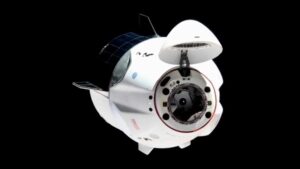Crew Dragon moves to new docking port at ISS
By Jeff Foust

WASHINGTON — A SpaceX Crew Dragon spacecraft moved from one docking port to another on the International Space Station April 5, marking the start of a busy month spacecraft arrivals and departures on the station.
The Crew Dragon spacecraft Resilience undocked from the forward port on the station’s Harmony module at 6:30 a.m. Eastern. The spacecraft, with four astronauts on board, moved out 60 meters from the station, then shifted into position to dock with the module’s zenith port. The Crew Dragon docked with that new port at 7:08 a.m. Eastern.
The port-relocation maneuver, the first done by a commercial crew vehicle at the station, is part of a complex choreography of vehicle activity at the station. This maneuver will allow the next Crew Dragon spacecraft to dock to the forward port when it arrives at the station later this month on the Crew-2 mission.
This, in turn, will free up the zenith port after Resilience returns to Earth in late April for the next cargo Dragon mission, scheduled for June. The cargo Dragon spacecraft needs to dock with the zenith port so that the station’s robotic arm can retrieve equipment stowed in the spacecraft’s trunk section, which is not accessible if the cargo Dragon docks with the forward port.
While the port-relocation maneuver is brief, it is complex. “It is a pretty amazing thing to do a flyaround,” said Kate Rubins, a NASA astronaut on the ISS who participated in a similar maneuver involving the Soyuz MS-17 spacecraft, which moved from a docking port on the Rassvet module to one on the Poisk module March 19. That maneuver will free up the Poisk module’s airlock after Soyuz MS-17 returns to Earth for later spacewalks from the station’s Russian segment.
“It’s all of the fun and the work of undock day, plus all of the fun and the work of docking day,” she said during an April 2 appearance on NASA TV. “It’s a lot of activity, but it’s pretty cool.”
That appearance was an event to mark the 10th anniversary of the commercial crew program at NASA, although work on commercial crew at the agency started well before the program formally started in 2011. The Crew Dragon at the station is flying the first operational commercial crew mission, Crew-1, which launched in November.
Among other benefits, the program now allows the station to have seven people on the station at a time, which includes four NASA astronauts and a fifth from the Japanese space agency JAXA. “It’s been really enabling for the station and what we can do up here,” said Mike Hopkins, commander of Crew-1, during that NASA TV event.
Rubins noted the advantage of the additional crew during a recent series of spacewalks. “We were able to have four people really fully focus on EVAs and Shannon [Walker] was able to keep all of the station things running that we normally have to stop when we get into EVA season,” she said, such as science experiments.
The relocation of the Dragon kicks off a busy month of station activities that will result in a complete change of the station’s crew by the end of the month. On April 9, the Soyuz MS-18 spacecraft will launch to the station, carrying Roscosmos cosmonauts Oleg Novitsky and Pyotr Dubrov and NASA astronaut Mark Vander Hei. On April 17, Rubins and Russian cosmonauts Sergey Ryzhikov and Sergey Kud-Sverchkov will return to Earth on Soyuz MS-17.
The Crew-2 mission is scheduled to launch April 22 on the Crew Dragon spacecraft Endeavour, the same capsule that flew the Demo-2 mission last summer. It will bring to the station NASA astronauts Shane Kimbrough and Megan McArthur, ESA astronaut Thomas Pesquet and JAXA astronaut Akihiko Hoshide to the station, docking about a day after launch.
The Crew-1 mission will end April 28 with a splashdown off the coast of Florida, returning to Earth Hopkins, Walker, NASA astronaut Victor Glover and JAXA astronaut Soichi Noguchi. That capsule will be refurbished for a SpaceX commercial flight, the Inspiration4 mission, scheduled for no earlier than mid-September.
When the other commercial crew vehicle, Boeing’s CST-100 Starliner, will next fly is uncertain. That spacecraft was to make a second uncrewed test flight early this month, but NASA postponed it because of delays in vehicle preparations. A crowded schedule of ISS activities, as well as another Atlas 5 launch scheduled for mid-May, has pushed back that mission likely to some time this summer, after the next cargo Dragon mission.
That would, in turn, delay a crewed flight test of the Starliner with three NASA astronauts that had been scheduled for September. At the April 2 NASA TV event, Steve Stich, NASA commercial crew program manager, noted NASA was still planning four flights in the program this year, which would include SpaceX’s Crew-2 and Crew-3 missions as well as the two Starliner test flights.
April 5, 2021 at 05:50PM
via SpaceNews read more...

Post a Comment